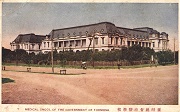|
Columns reporting on domestic people and events appeared on page 2 of either morning or evening edition. These reports concerned official and personal travels, new appointments or reassignments in the government and private companies, weddings and funerals, relocation, and opening ceremonies. In earlier times, these columns in the Chinese pages were titled 「南船北馬」(“Travels”) and 「人事.消息」(“People & Events”) detailing the people involved and the events that occurred. (Figure 14) Following the outbreak of the war and the subsequent page reduction, the contents became more condensed, reporting only the time and the incident. (Figure 15) In addition to the above columns, news on appointment of government personnel was reported from time to time, such as 「總督府辭令」(Order of the Government-General of Taiwan), 「高雄州辭令」 (Order of the Kaohsiung Prefecture), 「外務辭令」(Order of the Bureau of Foreign Affairs), 「厚生辭令」(Order of the Bureau of Welfare) and 「海軍辭令」(Order of the Navy).
Figure 14 News on personal travels reported in newspaper of earlier times contained more details not only on the itinerary but also the background of the person. For example, this October 22, 1933 issue reported that Hsu Kun-chuan of Qihou Town, Kaohsiung City, graduated from St. John’s University in Shanghai, had got his passport issued and would be visiting relatives in Singapore and Southeast Asia; and that the third son of Tsai Wu-ken of Qingshui Street would be marrying the daughter of Chuang Shui-po of Wuqi Street. Source: The Taiwan Shinminpo No. 960 (1933-10-22), Records of the Taiwan Shinminpo (T1119_02_022_0022).
The newspaper also reported dignitaries arriving in Taiwan by sea or air, with details on their names, the ships or flights they took and scheduled times of arrival. (Figure 15)
Figure 15 This issue of April 29, 1939 carried in the travel-related columns news on Dr. Nishimura Denzo of the Observatory of the Government-General of Taiwan flying to Japan at 7 am the day before on Flight Sakura. Radio message from Yamatomaru recorded fine weather but strong southerly wind and expected arrival in Japan at 3:00 pm on the 29th. There were many passengers on board, including engineers of the Government-General of Taiwan, councilors of the Hyogo Prefecture, staff of Okura Doboku Kabushiki Gaisha and Mitsui & Co., students of Taichung First Senior High School, and a group of staff from The Taiwan Shinminpo on visiting mission to Japan. The “People & Events” column on the left contained only brief updates in contrast to more details reported in earlier times. Source: The Taiwan Shinminpo No. 2661 (1938-07-02), Records of the Taiwan Shinminpo (T1119_02_079_0002). The newspaper also carried obituaries of local people with information of the funeral, burial and family network. During the war, there were notices published from time to time about funerals held in the city or town for the casualties of war, calling on ordinary citizens to participate in mourning. The list and biographies of the casualties were also reported in detail, as in the notice of the funeral held in Taipei City on February 5, 1938, announced in both The Taiwan Shinminpo and Taiwan Nichi Shinpo (Taiwan Daily News) (Figure 16)
Figure 16 The February 5, 1938 newspaper carried a full-page report on the public funeral held by the Taipei City for the casualties of war, detailing their names, ranks, residences, family backgrounds, and how they died in combat. The dead were all Japanese soldiers, aged between 20 and 40, who fought in the war against China. They all lived in Taiwan originally and most died in Shanghai. Source: The Taiwan Shinminpo No. 2515 (1938-02-05), Records of the Taiwan Shinminpo (T1119_02_074_0005). |
 |






